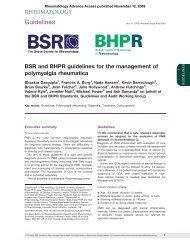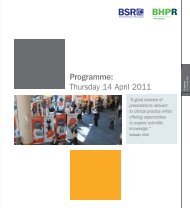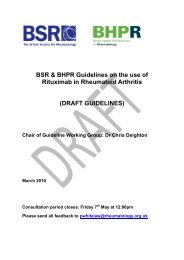Guidelines for the treatment of psoriatic arthritis with biologics
Guidelines for the treatment of psoriatic arthritis with biologics
Guidelines for the treatment of psoriatic arthritis with biologics
Create successful ePaper yourself
Turn your PDF publications into a flip-book with our unique Google optimized e-Paper software.
classification criteria. Psoriasis is a recognised feature <strong>of</strong> SpA <strong>with</strong>in <strong>the</strong>se criteria. This is particularly crucial in<br />
axial PsA as <strong>the</strong> disease is less likely to be bilateral and to involve <strong>the</strong> sacro‐iliac joints meaning that patients<br />
are less likely to fulfil <strong>the</strong> modified New York criteria <strong>for</strong> ankylosing spondylitis.<br />
Recommendations<br />
• Anti‐TNF <strong>the</strong>rapy should be considered <strong>for</strong> those patients <strong>with</strong> active axial <strong>psoriatic</strong> <strong>arthritis</strong><br />
according to <strong>the</strong> recommendation <strong>of</strong> <strong>the</strong> BSR guidelines <strong>for</strong> ankylosing spondylitis (REF).<br />
(Grade A). Consensus score 9.8<br />
CONCOMITANT PRESCRIBING WITH ANTI‐TNF<br />
Many <strong>of</strong> <strong>the</strong> randomised controlled trials <strong>of</strong> anti‐TNF <strong>the</strong>rapy in PsA used subgroup analysis to compared<br />
patients on concomitant MTX <strong>with</strong> those who were on anti‐TNF mono<strong>the</strong>rapy. There was no clear difference<br />
between <strong>the</strong> groups, although <strong>the</strong>se trials were not designed or significantly powered to assess <strong>the</strong> effect <strong>of</strong><br />
concomitant <strong>the</strong>rapy.<br />
Registry data from <strong>the</strong> South Swedish Arthritis Treatment Group have shown that persistence <strong>with</strong> <strong>biologics</strong> is<br />
increased <strong>with</strong> concomitant MTX use [25] . Specifically it seemed that <strong>the</strong> advantage <strong>of</strong> MTX was related to a<br />
lower rate <strong>of</strong> dropouts <strong>for</strong> adverse events [26]. Both <strong>of</strong> <strong>the</strong>se analyses combined all anti‐TNF agents and did<br />
not assess <strong>the</strong> drugs independently. Subsequently a smaller analysis <strong>of</strong> patients treated only <strong>with</strong> etanercept<br />
did not confirm <strong>the</strong> improved persistence <strong>with</strong> concomitant MTX [27]. The authors suggested that <strong>the</strong><br />
advantage <strong>of</strong> concomitant MTX seen in <strong>the</strong> Swedish study may have been due to <strong>the</strong> patients on infliximab<br />
(around 40% <strong>of</strong> <strong>the</strong> registry patients) and that concomitant MTX may be less important <strong>with</strong> etanercept or<br />
adalimumab [27]. Registry data from <strong>the</strong> British Society <strong>for</strong> Rheumatology Biologics Register (BSRBR) has<br />
shown similar EULAR response rates in patients receiving concomitant MTX, o<strong>the</strong>r DMARDs and biologic<br />
mono<strong>the</strong>rapy [28].<br />
Ciclosporin is <strong>the</strong> only DMARD evaluated specifically <strong>with</strong> anti‐TNF <strong>the</strong>rapy. A small open‐label study recruited<br />
patients on etanercept <strong>with</strong> ongoing active skin disease and added ciclosporin (3mg/kg/day) to <strong>the</strong>ir<br />
etanercept. The majority <strong>of</strong> patients showed an improvement in skin psoriasis over <strong>the</strong> 24 week study period<br />
<strong>with</strong> only one <strong>with</strong>drawal due to adverse events [29]. However <strong>the</strong> long term effects <strong>of</strong> combining anti‐TNF<br />
<strong>the</strong>rapy and ciclosporin are not known, and <strong>the</strong> combination is not recommended in dermatological practice.<br />
Outcome measures<br />
As stated above, <strong>the</strong> PsARC is <strong>the</strong> current recommendation <strong>for</strong> response assessment in peripheral <strong>arthritis</strong>.<br />
The ACR response criteria have also been shown to be discriminative in polyarticular PsA [14], but are<br />
generally too cumbersome and time consuming <strong>for</strong> routine clinical practice. O<strong>the</strong>r composite <strong>arthritis</strong><br />
measures have been validated in PsA. The EULAR responses, based on <strong>the</strong> DAS and DAS28 scores have been<br />
shown to be responsive in polyarticular disease [29] but <strong>the</strong>re are numerous concerns about <strong>the</strong>ir use in <strong>the</strong><br />
general PsA population (i.e. lack <strong>of</strong> validity in oligoarticular disease or those <strong>with</strong> predominant lower limb<br />
involvement, remission cut <strong>of</strong>f validated in RA but not in PsA , global disease activity may be influenced by<br />
o<strong>the</strong>r aspects <strong>of</strong> <strong>psoriatic</strong> disease [such as en<strong>the</strong>sitis, psoriasis, axial disease], PsA patients show a less linear<br />
relationship between disease activity and acute phase response).<br />
The disease activity in reactive <strong>arthritis</strong> (DAREA) score was originally developed <strong>for</strong> use in reactive <strong>arthritis</strong> [30]<br />
but has recently been assessed and validated in two cohorts <strong>of</strong> PsA patients[31, 32] and <strong>the</strong> authors have<br />
proposed using it in PsA as <strong>the</strong> disease activity in PsA (DAPSA) score. The DAPSA includes joint counts, patient<br />
reported outcome measures (PROMs) and an inflammatory marker and has been shown to be responsive in<br />
polyarticular disease. The DAPSA may represent a useful measure <strong>of</strong> PsA peripheral <strong>arthritis</strong> activity in future<br />
as it is feasible in clinic and allows a measure <strong>of</strong> disease state ra<strong>the</strong>r than just a response outcome such as <strong>the</strong><br />
9
















